
STARTING FLAMES OF WAR
Welcome to Flames of War the 15mm (1/100 scale) Historical Wargaming System which focuses on WWII, Vietnam and Arab Israeli Conflicts of the 20th Century.
This Article will focus on the newly released Version 3 rules and as such will remain a live document, dynamic to future changes and any special rule changes. It is a long article and is a Collaborative effort from the Dakka FOW community to help those people out there make the leap to FOW.
The fact you are here means you have more than a passing Interest in this game, which may yet develop into collecting a force for battle. The aim is to produce a guide to collecting your first force and give you a fighting chance and also to reduce the outlays and ensure you don't end up buying a force you will never use and grow disheartened with before drifting away from FOW altogether.
Things you need before embarking on building a Rules of War force (for Wargaming).
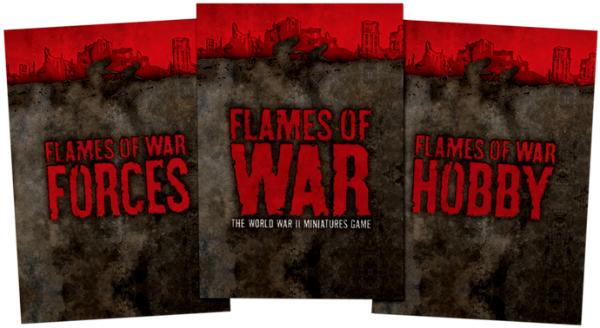
1. The V3 Rule book (complete set of 3 as above approx £30) or the small Rule book which you may be able to get from the internet or a generous friend.
You don't need a compilation book to play, the Forces Book contains all the points values and lists to create your force. You only buy a Compilation book if you want too, or you prefer fighting specific scenario's.
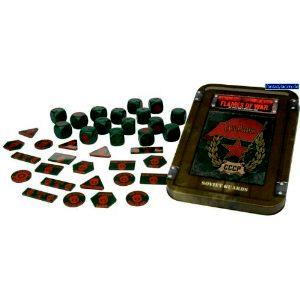
2. A Game Tin for your force (contains tokens and dice, dice are unimportant as any can be used, but Tokens are very useful though you can make you own out of card or paper). This can be bought later on, plus it's good to buy one that matches your force, this is a nice to have and not a necessity. As another option a new player may wish to purchase just the Token set that is appropriate to the force that they choose to start with.
Since V3 BF have changed their tokens to Generic sets, rather than the individual army or force tins. So if you like them grab one soon, before they become rare and rocket in price.
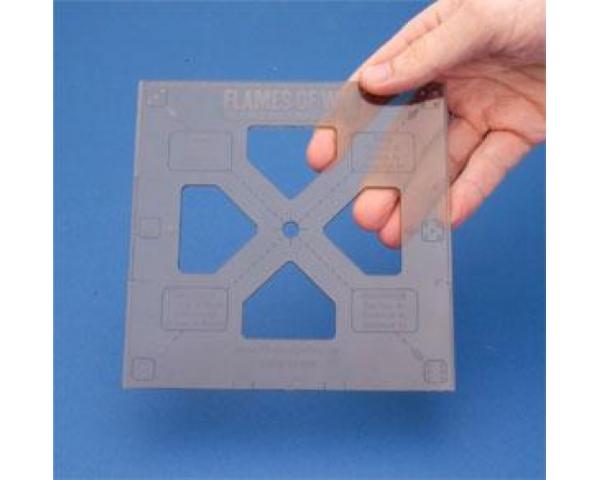
3. Tape Measure and FOW Artillery Template. The Flames of War artillery template is extremely useful and will assist you no end but is chiefly for Artillery and Aircraft attacks. There are other templates with useful distances on it, but if you have a tape measure you are fine.
I have written this article as if you already have the above.
Overview
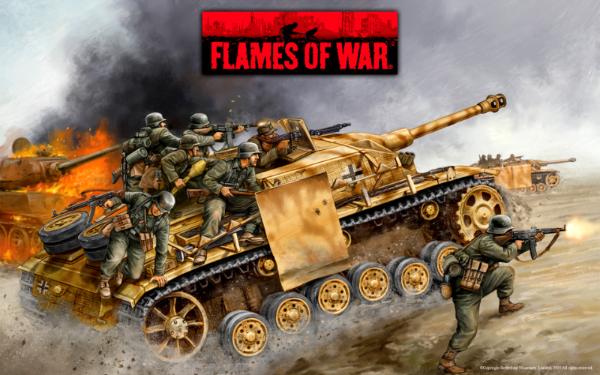
Everyone in the military is in a Team, no man fights alone. So forget the individual, it's all about team work.
There are individual "Warriors" who represent real world Heroes such as Stan Hollis VC or Michael Wittmann, these are prohibitively expensive and are not often seen on the battlefield but usually add significant "punch" or special abilities. However they are just a man, and can be killed as easily as any other.
The Idea of FOW is that you are Front line Company Commander probably a Major in Rank (or maybe a Colonel Battalion Commander if Russian). You have a core Company under your command, this comprises of a HQ section and a minimum number of Combat Platoons.
A Platoon is a group of Teams usually lead by a Junior Officer (Lieutenant/ Captain). In the Western Hemisphere this is usually 28 - 35 Soldiers, with a 1 - 4 Sergeants depending. This Platoon Moves and fights as one, providing supporting fire and operating as an Independent, mutually supporting unit. Tanks, Guns and Artillery are all also broken into Platoons, from 2 - 5 units. With very heavy Tanks/ specialist units sometimes only having a single unit in the Platoon e.g Tiger Tanks.
As Company Commander you can call upon further support from Weapons Platoons. These represent Battalion assets left at your disposal by your Battalion Commander, things like Anti-tank Guns (AT), Mortars, Heavy Machine guns (HMG). However you also have your Divisional Commander who may allocate other assets to you from his Pool of reserves. These maybe Heavy Artillery units, Aircraft , Tanks, Tank Destroyers and a Myriad of possible units.
Welcome to World War II
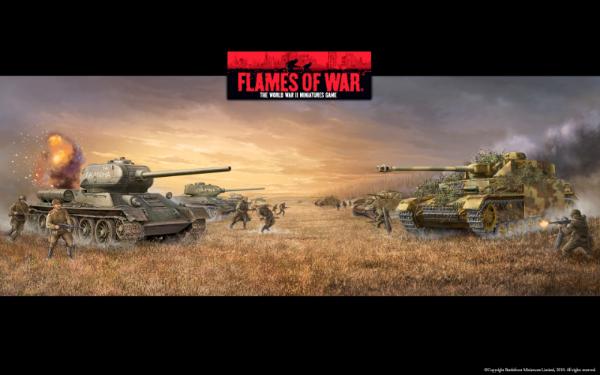
The 1st thing to do is to decide what period you are fighting in?
EW - Early War Period 1939-1941
MW - Mid War Period 1942 - 1943
LW - Late War Period 1944 - 1945
All Army books in FOW are for a specific period (EW, MW, LW), the units, equipment and abilities vary depending on the period.
It is important to remember certain things when buying miniatures, British Para's and American Airborne are great but didn't come into their own until the late war period (D-Day, Arnhem etc). Therefore buying this force will limit you to Late War games. Equally some units remain throughout the war relatively unchanged (thinking British Rifle Platoons) although by late War they had a few more Transport and extra options.
Vehicle and Armored units, changed quickly over the course of WWII but almost all vehicles were used once created. Nations always found someway to employ obsolete vehicles . So EW vehicles will have some use through MW and LW, even if you have to proxy a tank (e.g that PANZER IV D is actually representing a PANZER IV F for example) most players are happy with this, but do not try this at Tournament play as it is considered bad form.
A fair bit of time invested now, will reap rewards later on, and avoid buying those units that are limited and you will love but rarely use.
The 2nd thing to do is decide on what theatre to play?
1. EW Western Front (Trying to hold off the German Blitzkrieg in 1939 - 1940)
2. MW North Africa (Trying to use your AFRIKA KORPS to cut off the British supply lines in SUEZ)
3. EW / MW / LW Eastern Front (Can you take Moscow?)
4. MW Italy ( Are you the new Caesar?)
So these are a few examples but there are many.....
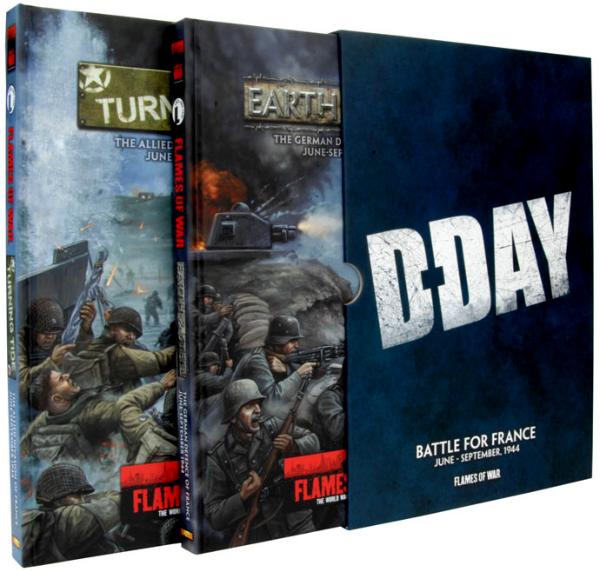
The 3rd thing is what book are you using?
You don't have to use any Book, as the V3 Forces book has a number of Late War lists, which is more than sufficient but if you really want to fight a specific period of theatre you can get hold of Compilation Book. My advice here is to buy a Compilation book, they are more expensive (About £30) but include a large number of lists and are therefore great value for money. The other examples are smaller books (about £10) that are for specific engagements or battles, (e.g. Hells Highway, Market Garden) these are more restrictive and will limit the numbers of opponents and periods you can fight across.
If you want to try before you buy you can see Sample PDF's of free Books on the "Flames of War" website. Use the link below and peruse some of the Intel briefs (mini-books) most of the compilation books are 200+ pages long.
http://www.flamesofwar.com/Default.aspx?tabid=108
Good examples of Late-War compilation books are
1. Red Bear
2. Grey Wolf
3. Earth & Steel
4. Turning the tide
They generally are amalgamations of 3 or 4 smaller books anyway, with some extra content on top of this. There is a good website that gives you access to the books for a small fee.
http://www.easyarmy.com/index.aspx
(create a Login and try out the Blitzkrieg list because it's free!)
This has the advantage of you paying only $2 dollars to unlock the book you want (relatively cheap) you can build your armies, save it and print it out so you have a nice list to fight with and not written on the back of a scrap of paper. I have used this service and have unlocked 5 Books (costing $10 whole dollars! which is a steal at twice the price!). Best of all Battlefront approve of this site so it's not as if you are pirating books which is always nice to know. It means you can try out lots of builds stick them up on here and people can dissect them.
FIRST TIME PLAYER
For a 1st time player I would recommend a Tank Army. There are several good reasons for this.
i, It is cheap to collect.
ii, Keeps the rules simple and therefore easier to learn.
iii, It will be usable with other force lists (infantry, recon etc) as you grow and expand within the hobby.
iv, It is quick to paint. Battlefront, as well as several other manufacturers, have made available spray cans with the correct color to basecoat each nations tank forces. Much like spraying a base coat of Dark Angels Green on a Space Marine squad, picking up a can of one of these basecoat sprays can drastically speed up your painting if you decide to build an armored force
v, It allows you to get to the table and start learning.
From this MW is a good period as much of the armour was still relevant in Late War. Examples such as Panzer IV, T-34 or Sherman make good 1st Armies and don't cost the earth. You will need AAA, Recon and possibly Artillery for laying smoke. In order to create your list, for a set points value 1500 points is normal, 1750 is very popular and 2000+ or 1000 points or less relatively rare.
While collecting an armored (read:Tank) force does hold many advantages, as pointed out above, the most important thing to ask when selecting a starting army is "will I have fun painting and playing with this army?" I've found Flames of War to be very similar to 40k in one regard, choosing an army based on aesthetics tends to make painting a joy while choosing another army for the sole purpose of winning can be unfulfilling and result in a large amount of unpainted figures on your work bench.
Force Composition
When building an Army ask yourself what is your aim? A few friendly games as an introduction for you and maybe a friend/ family member? Is to take part in a Club event or small gaming group? Is it for competitive Tournament play? Or do you just like painting?
The second thing to ask is "Do I care about Historical Accuracy?" surprisingly in a game that has been tweaked for balance alot of players strive for historically accurate lists (i have no idea why because this game is not a Historical Wargame, but is rather a Wargame in a historical setting). This makes a difference as players will take inferior units, or deliberate bad choices in their lists to be fluffy (to each his own!). Equally some gaming groups will only fight other "historical type" gamers, this can be a serious PITA, so I would advise a new player to go with whatever they want and ignore the historical accuracy element for now (Battlefront has done this for us in alot of cases anyway for balancing purposes and to make more viable lists). Going for Historically fluff list will leave you out of pocket, with some very limited units that don't fit in every list (thinking captured French Armour, artillery etc that was pressed into German service).
As detailed above, as the Company Commander you can call upon further support from Weapons Platoons (the Middle Column below) and also Divisional Support (the far right column below).
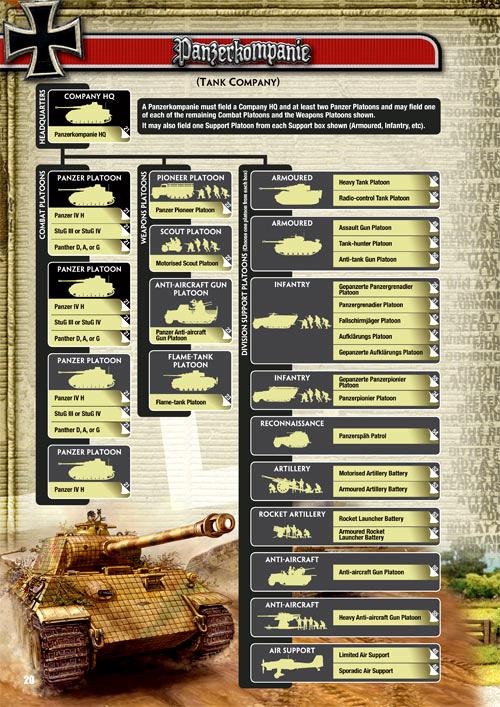
All will be allocated in accordance with your Force List structure with associated points costs. As per the diagram above taken from a Compilation Book, You must take 1 each of the Black choices (usually a HQ and 2 Combat Platoons). You may then take 1 Platoon from each of the Grey boxes on the list.
The page references to the right of the silhouette give the page you need to look at in order to get the points value of the platoon. Sometimes you can have numerous options, to represent the points price of a Platoon of 5, or the points for a Platoon of 4 or 3 etc etc.
It's the overall points battle that you and your opponent are fighting that determines how much you can take in your force. E.g. 1000 point battle cannot exceed 1000 points, a 1500 point battle cannot exceed 1500 points etc.
As stated in the FAQ below, common points values are 1500 points and 1750 points. This will give a game that will have between 4 -8 Platoons a side and take about 1.5 - 3 hours depending on your knowledge of the rules and slowing down to ensure assault etc move forward correctly.
Modelling your force
Flames of War has some conventions for modelling or more specifically basing units. All Infantry and Gun teams will be based together on Bases, Casualties are removed as teams become incapacitated.
Vehicles do not need a base, however some manufacturers like Forged in Battle come with them moulded on.
There are 3 principle base sizes, Small, Medium and unsurprisingly Large.
Small bases are for HQ's, specialist units (Bazooka teams, small light mortars etc)
Medium bases are for Infantry teams, Medium Mortars, HMG's and Light Gun's or Infantry artillery (small field guns)
Large bases are for Large Guns, Artillery and also for certain Teams such as Reloading teams for Armoured Rocket artillery etc
Overall Guns and Artillery are easy to base as they come with bases and are so large it cannot be based on others. However Infantry can be problematic due to the composition and numbers in every platoon. Most Infantry teams are 4 men, with some specialist units like German Fusillers (can be a mixture of 4man and 5man teams).
It is nice to have accurate models but in my experience many players are pretty good about it, so long as you are not trying to pretend a Rifle team is actually an MG team and it shoudn't be. Proxy is fine for most people but don't use this as excuse for bad sportsmanship ("I forgot to say that one is actually a Flamethrower!" is bad way of making friends and influencing people!).
A better guide to this is at Question 9. of the FAQ.
----------------------
Good Starter Sets
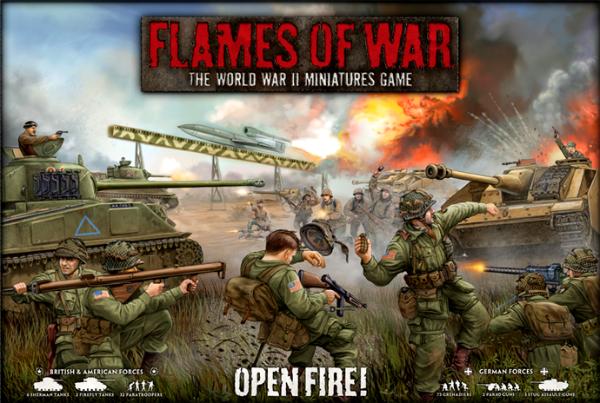
OPEN FIRE SET
The new OPEN FIRE SET is actually a really good setup, (apart from the needless V2 launch unit?) .
It comes with:-
GERMAN
2 x Grenadier Platoons
2 x Pak40 Guns
3 x STuG Assault Guns
ALLIES
2 x Sherman Tank Platoons (+ Firefly)
1 x US Para Platoon
Plus all the extra's and books etc.
I would recommend buying this boxed set as it gives you value for money, plus you can swap the items. I think the best way is if you and friend who wants to play both buy this, and you swap the models one for one resulting in much bigger forces and also you can always top-up with extra plastic platoons as people sell them on Ebay.
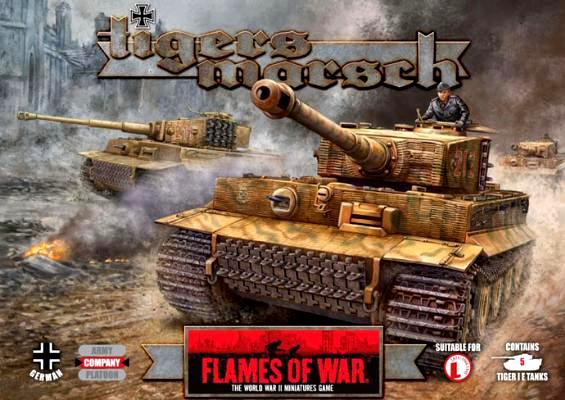
GERMAN
A Good start for a New player is possibly the Tigers Marsch Boxed Set. This is a LW boxed set but Tigers can be used in MW books (Tigers in Tunisia). It's not too expensive, it's quick to paint and you get the Tigers which are a lovely model and are fearsome opponent on the Battlefield (these things are the Thunder Hammer /Storm Shield Terminators of the FOW world, well for the Germans anyway).
http://www.flamesofwar.com/hobby.aspx?art_id=452
Price approx £40. Add in a small infantry section approx £15 form forged in battle and AAA from forged in battle £20. All done £70. That's cheaper than many starter sets for other war game systems.
Advantages, you get the Tokens and dice (You usually have to pay for these separately in a tin). It doesn't take many tanks to make a list (approximately 5 of these which is how many you get in the box ! ;) )
For an SS List gives 1 Tiger HQ, 2 x Two Tiger Platoons. Then add in 3 x AAA and Pioneer platoon (2 x sections + 2x 251/7)
gives 1500pts (Earth & steel book - SS Schwere list).
This list is easy to learn and will get you to the battle field quickly and allow you to learn "On the Battlefield" rather than from dusty old forum venting like sages from another age.
In summary this is a good list for a beginner because it is relatively cheap, has a couple of freebies, it's competitive and easy to play (thus very motivating), it also will allow you to use your units in other lists (Tigers are common in late war) although it is unlikely you will use all 5 outside of Panzer Schwere list.
AMERICAN 82nd AIRBORNE
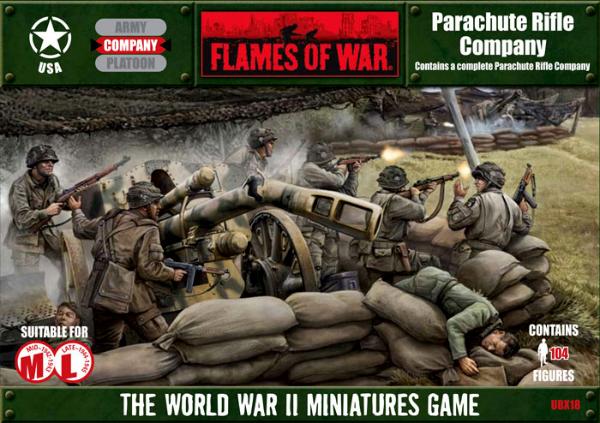
This is a slightly different take on a starter force, it's not tanks and it's LW, not MW, but there's a method to the madness. Sure, taking paratroopers instead of tanks means you're going to be painting a lot of tiny little men, but they're elite troops, so there's less than you'd see in a full fledged infantry company. Plus, if you're looking to start with a more traditional tank force you can do so while still making progress on your paratroopers. The 2nd Armored Division list in Turning Tide lets you use a paratrooper platoon as your infantry support, so you can build that (it's just a few boxes of Plastic Soldier Company M4A1 Shermans, 1 box of the 76mm version, 2 or 3 of the 75mm ones) and have something to play with while you're finishing your airborne force.
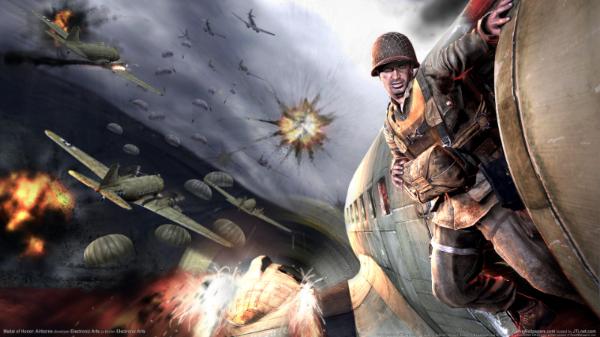
Anyway, back to the actual airborne force! To start, grab one of the US Parachute Rifle Company boxed sets, either the discontinued UBX06, if you can find it, or UBX18 if you can't. The older boxed set has 3 platoons of rifles, the HQ, some snipers, a pathfinder and a supply wagon. The new box is just 2 platoons of rifles and the HQ. Both come with a bunch of mortars and bazookas, as you find those at basically every level of a US airborne force.
On top of your core troops, you're going to want to consider artillery and anti-tank. For artillery UBX15, the parachute field artillery boxed set, does just what you want, but it was just discontinued. You may be able to still find it, otherwise just look for blisters of 75mm pack howitzers. For anti-tank you really want UBX16, the airborne anti-tank platoon, but again, that was just discontinued. If you can't find the boxed set the constituent parts should be available in blister form.
Finally, if you want armored support you need M4A1 Shermans. Conveniently enough, you'll already have those lying around from your 2nd Armored Division build, otherwise, off to Plastic Soldier Company for you!
The total for a playable 82nd airborne list is something like $140 bucks off of eBay ($60 for the UBX18 parachute rifle company box, $40 for the field artillery box and $40 for the anti-tank box), plus $25 bucks for 5 Shermans from Plastic Soldier Company if you want to have some tanks. It's more expensive than just getting a tank force, but for another $50 bucks you get most of the rest of a tank force to go with it, and who are we kidding, paratroopers are cooler than tanks anyway!
RUSSIAN
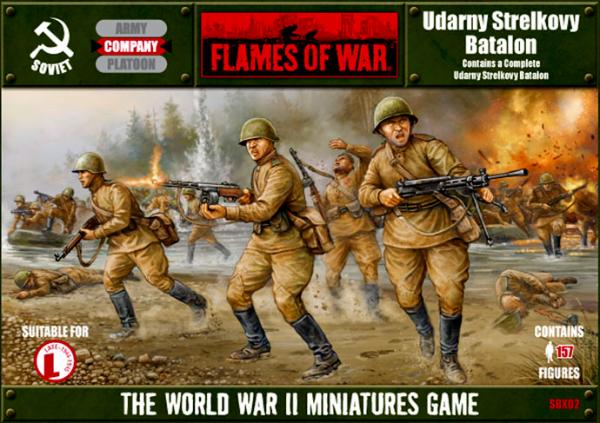
A Strelkovy Battalion is a cheap way of buying a Company sized force (bare in mind the russian boxed set can lead to confusion, although this is a Battalion it is a considered a Company in game due to the huge amount of low quality troops the Russians use.
I believe a Mid-War/late war TANKOVY force is also a good force for a new player. It will require a fair amount of tanks, and alot of painting.
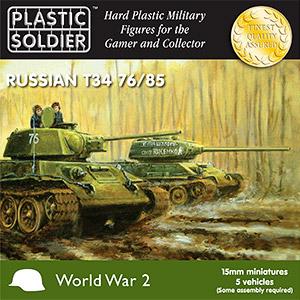
Using Plastic Soldier Company Box set of T34's you can build a large force of Tanks really Cheap (I mean Really Damn Cheap!). An added bonus of using Plastic Soldier Company's T-34 box sets to build a Mid-War TANKOVY force is that the set comes with the parts to construct the more advanced Late-War version of the T-34. This, plus the fact that the Mid-War T-34 is still a mainstay of Eastern Front Late-War TANKOVY forces makes the Plastic Soldier Company's T-34 Box Set one of the best buys available to the starting Soviet player. They also do a Company Deal so you can buy 4 or so boxes (20 tanks!!!) for a decent discount, which adds value to an already cheap force!
BRITISH
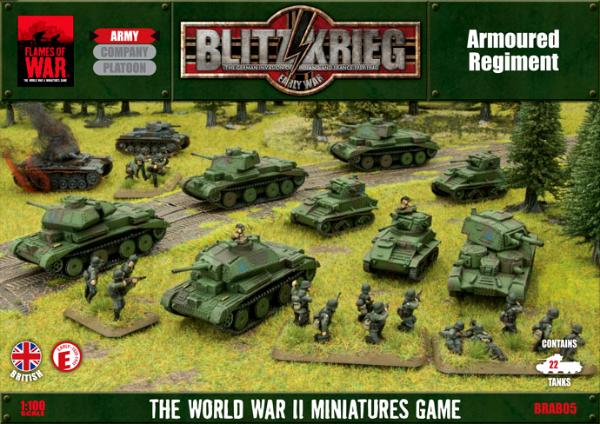
For the British force I think an EW (Early War) Royal Tank Regiment force, or a LW (Late War) Guards Armoured force, with Shermans etc all cheaply available from Plastic Soldier Company.
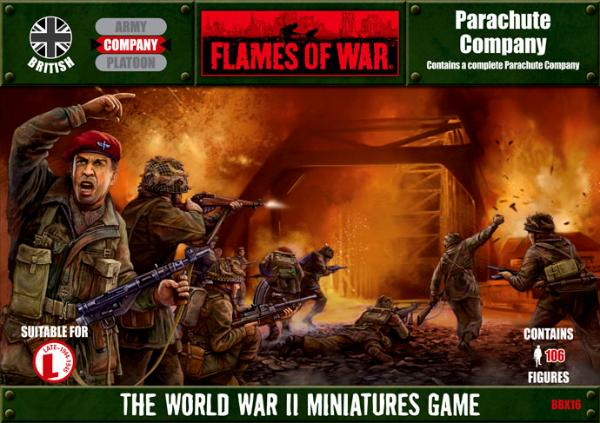
Finally another good option is a British Paratroop Company is also a very good buy, but would need extra platoons to make it into a decent force.
-----------------
Considerations for the future
Remember that certain armies will be very specialist nature requiring different tactics and the ability to use all of your previously collected miniatures in that Faction may be limited. Clever force construction can minimise waste when you make your first foray into the hobby. A couple of years down the line, you may then want to specialise in more specific or bespoke armies, when time, funds allow and also your experience will allow you to play them well.
An Aufklarungsschwadron list is exactly one of these lists. Available from Battlefront (link below) and is an interesting example of this phenomenon.
http://www.flamesofwar.com/Portals/0/Documents/Briefings/Mid-war/Aufklarungs-Afrika-Mid-war.pdf
This is a good fun list for a more experienced player but for a beginner it has several draw backs.
1. You will need to invest in alot of 250/1 vehicles which were essentially a cut down 251. These are expensive and to make the core infantry you will need alot of them. 251's are used throughout the war and in many lists, so from a flexibility standpoint I would avoid this list unless you have alot of spare cash and desperately want this list. You would need 10 of them in total for 2 Full Platoons and a HQ.
http://www.firestormgames.co.uk/flames-of-war/fow-german/763
So at 6.75 each = £67.50 just for vehicles! no troops, tanks, AAA, Arty etc, ouch that's expensive.
Where as a 251list allows you to use Plastic Soldier Company 251's which cost £16.50 for 5.
http://theplasticsoldiercompany.co.uk/index.php?main_page=product_info&cPath=1_22_24_50&products_id=206
So 10 vehicles would cost £33.. Okay thats alot more reasonable and just over half the price of the 250/1. Plus you can use these 251's in EW / MW / LW in many lists, The AUFKLARUNG list is limited to those books that allow this list and they may vary in their composition.
2. If you want Recce in the Weapons Platoons you could have 2 Platoons. However most German lists only allow one, so if you in vest in two platoons you will probably ever use one if you change list. Thereby restricting your 2nd Recce Platoon to only this list.
3. Apart from needing alot of vehicles to make the list, it also needs finesse to be good due to the complexitity of the force and the special rules of Recce units.
In summary this is poor list for a beginner because it is inherently expensive and complex to play (thus demotivating), but is very rewarding to a Veteran Player who will wring out every advantage from this list.
FREE BESPOKE RULESETS
Many members of the Community have produced Rules bases on the FOW Rules in order to game other Periods.
http://stoppingtheredtide.blogspot.co.uk/ - Run by mwnciboo focuses on NATO vs WARPAC 1986 Fulda Gap type scenario's with much more modern equipment and is
- Run by mwnciboo focuses on NATO vs WARPAC 1986 Fulda Gap type scenario's with much more modern equipment and is
http://brokelow.blogspot.co.uk/2013/04/rules-for-fow-six-day-war.html - Amroth produced the 1st Books on the Arab vs Israeli conflicts they are still great books
- Amroth produced the 1st Books on the Arab vs Israeli conflicts they are still great books
http://ndcblog.wordpress.com/1973-flames-of-war-the-yom-kippur-war/ - Natholeon also produced some interesting work on the 1973 Arab Israeli Conflict.
- Natholeon also produced some interesting work on the 1973 Arab Israeli Conflict.
FOW FAQ
1. What scale is it?
1/100 or 15mm scale, Aircraft are usually 1/144 to keep the models a reasonable size. Some HO Railway items are compatible and TT guage is perfect although very rare.
2. Is it like 40k?
Yes and No, It's simple to play mechanics and clever balancing make it fun to play. The lack of super charged characters and Uber assault units make it feel different. Also Matt Ward hasn't re-written World War 2 to include some off the wall elements so actually its not like 40k and the main reason is detailed below. The most noticeable difference between Flames of War and 40k is that the former has many more variations in missions than the latter. While both systems are predominately objective based, Flames of War is based around ten core missions found in the v3 rule book, the selection of which can radically change how 2 disparate forces fight each other on the battlefield. Contrast this with 40k in which 2 out of the 3 main missions require both teams to go on the offensive in order to claim objectives and win.
There are many other significant differences between the systems but suffice it to say that if you enjoy 40k's mechanics but are searching for a bit more tactical depth then Flames of War might be just what you're looking for.
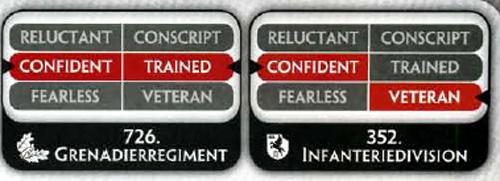
Each Platoon has two Ratings. Morale and Competency, so a Fearless Veteran Unit is solid where as a Reluctant Conscript Army is more fragile. As you can see these details are at the top of the list and vary from regiment to regiment, unit to unit, army to army and faction to faction. It makes a big difference to the chance that your unit will achieve what you have set it as Skill Checks drive FOW forward. So what is a skill check? It is a simple D6 roll, a Skill Check for a Veteran unit is successful 3+, Trained is successful on 4+ and a poor old conscript successful on 5+. This means if you want to dig in, Tank assault, etc you need to pass a skill check, the better the unit the more likely it will achieve it. It also means some units become very expensive in terms of Points because they are dependable.
The historical element means that 40k Super armies don't translate, the Germans are superior and smaller in number and expensive (i suppose akin to Space Marines). The Russian's are more like Imperial guard however these comparisons are well off base and 40k does not translate into FOW in reality. Remember that WW2 actually happened and 40k is a load of old fantasy tosh (I like it but it's still b*llocks).
The Platoons fire is determined by the Weapons they carry (very sensible) so Machine guns, rifles, mortars etc. With a Rate of Fire, so a HMG or LMG has a much higher ROF than a rifle section.
The Platoons fire but hit based on their enemies skill level (Huh? you say?) .So the Platoon rolls a Dice to hit based on their enemies skill level (Veteran hit on 4+, Trained 3+ and Conscript 2+) this represents Veterans use move and cover tactics more effectively, knowing that to stand in the open invites a rapid death. Whereas a Conscript unit is almost lambs to the slaughter.
Equally ; distance, concealment and being gone to ground add modifiers which can make Veteran Troops Gone to Ground, concealed and at range impossible to shoot (You cannot roll 7+ on a single dice!).
You can split fire, so half a Platoon may fire at a building whilst another fires as group of enemy in the open.
You may also split platoons but they must remain in Command distance which is the distance between units to keep contact and communications between them.
3. Is it Cheaper than 40k?
Without a doubt! There is no IP claim over WW2 so there are literally tens of manufacturers of 1/100 (15mm) military vehicles. This means that competition is fierce and prices reasonable. Some company's have produced very cheap high quality tanks, troops and vehicles and this is all good for the FOW community.
You can make a 1500 point force for around £60 (See Tigers Marsch above). Which will literally buy you AOBR for 40k which is no where near 1500 points.
Buying alot of books can be expensive but read above for cheaper alternatives.
4. Is it simple to learn ?
Yes, alot easier than 40k.
5. Is it well supported?
YES! Batttlefront runs a magnificent Website and gives out free PDF Army lists on almost a Bi-monthly basis (Like a free mini-codex) they also listen to the fan base and design relevant terrain and pieces. Wargames Illustrated has at least one article per month and usually more on FOW.
6. It seems a bit old man?
Maybe, but I'm relatively young at 30 and am encouraging more to take it up, it's enjoyable, cheap and social activity. Plus it can teach you a bit of real world history. Also if you have a family link to WWII it can be very satisfying to collect a force that your family has a personal connection with.
From my experience the Demographic is significantly older and I don't seem to play little boys or teenagers (which is a nice change from the sometimes socially inept 40k unhygienic trolls I've seen and played over the years). It seems to be young adults, fathers and the middle aged crowd that enjoy this most and I actually enjoy this more mature demographic.
7. It seems a bit two Dimensional and straight forward?
Looks can be deceiving, The ability and use of tactics can make even Conscript Armies steamroller Veterans. Use of Smoke, pinning the enemy with Fire, and then assaulting reduces the enemy Rate of Fire (ROF) so their Defensive Fire is much reduced when you charge in the last few inches to assault the enemy.
Effective use of Cover/ Concealment/ Bulletproof cover, ambushing, Recon, Artillery and Aircraft add layers of complexity to what seems a simple game. It's more about tactics than about dice rolling, though luck does play it's part like in real warfare.
8. I don't like Metal/ Resin/ etc or the Cartoon look of the figures?
Funny old thing as previously stated there is no IP for WWII. So there is a vast amount of alternative models out there, mix and match can work with some lines. here is a link to the main supplier Article by George Spigott.
http://www.dakkadakka.com/dakkaforum/posts/list/247904.page
9. How do you assemble an army?
Here is are some pictures that show you how assemble an army. You can click on them for a better view.
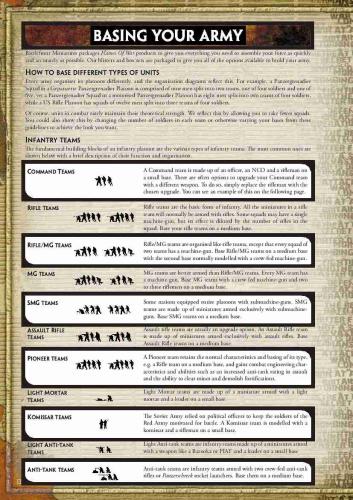
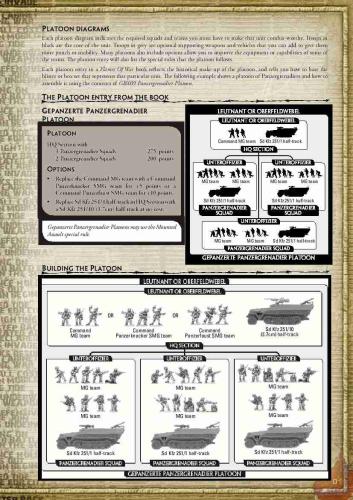
10. How does wound allocation work with 4 -5 figures per base?
The Whole base is a team, so counts as one. Wounds really represent units become ineffectual from being wounded or attending those who are dead and dying, so Platoons can rapidly become ineffective if exposed to effective enemy fire. So if a Team fails it's infantry save, then the whole stand is removed. It may seem harsh, but in WWII weapons were extremely effective and with the millions of personnel involved casualties even in a minor skirmish casualties would be shocking by today's standards.
W
11. Is there anything that I should know before I run out and start buying and building my force?
Just a few pointers to help out new players:
1) Don't glue your turrets in place. Turret facing can be very important in Flames of War!
2) Be careful to research the units available to the army you want to play before you make a purchases. The wide variety of force structures available to each nation (and across each era) mean that, unlike 40K, not every unit is available to be used by your chosen force, even if it is made for the same period.
12. Is there anywhere else I could go for information?
1) Flames of war's official site: http://www.flamesofwar.com/
2) Flames of war's youtube channel http://www.youtube.com/user/flamesofwar/videos
FOW General Tactics
In no particular order
-Always look to take an Even Number of Platoons in your Force, as this makes a difference to not rolling your "Morale Check until you have destroyed over half the enemy platoons" e.g Killing 2 platoons of 3 would result in a check, Killing 2 Platoons of 4 would result in nothing. Even numbers are better.
-Always consider the Side Armour of Tanks, getting yours into a position where they will be much more effective.
- Gun Placement is key :-
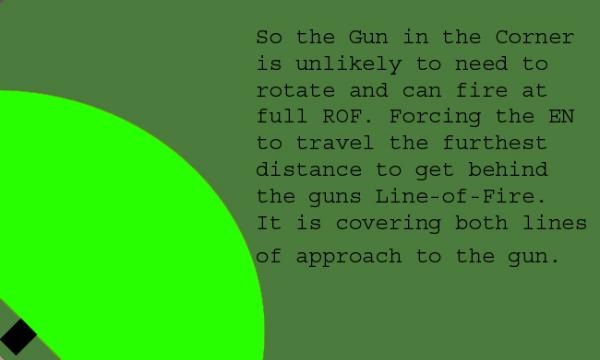
Placing this in the Corner, means the gun cannot be crept up on from behind, you can keep up the maximum rate of fire, and cover a huge arc across the Table (dependant on range, 88's or 17 pounders will obviously dominate. Plus you can screen your guns with infantry or other units.
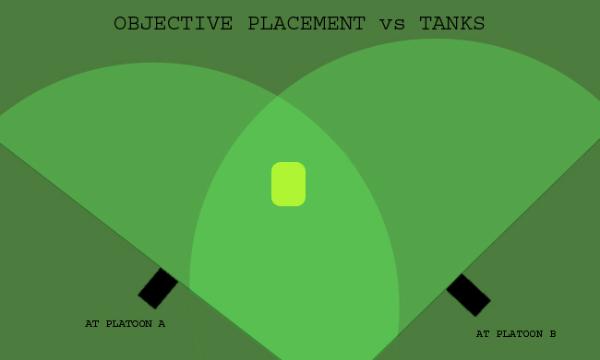
Again placing AT Guns (or tanks / Tank destroyers) effectively in Defence is critical, the overlapping range should be done 4" around the Objective. Plus you can force the enemy into the open by placing Objectives in Open ground, forcing the enemy to either try and neutralise your guns with artillery (difficult if you are concealed and gone to ground) or running the gauntlet and leaving themselves exposed as they try and take the objective.
You should always bear in mind the enemy's like approach route, and aim to intercept them with flanking (enfilade fire) and is much more effective against Side Armour but is difficult to achieve with AT Guns unless they are in Ambush or in a Gun Emplacement (D-Day type Gun Bunker).
-Don't spam units. Unlike some other games where you might find a unit that works, and use as much of that unit as possible. It is better to have a good mix of units. So don't just use an all tank list, all infantry list, all guns list. Try to figure out what combinations work in what amounts.
-Use cover and terrain as much as possible. Unlike some other games such as 40k, terrain is absolutely vital to the game. Infantry (and even tanks) moving in the open are very easily killed. Use it when ever possible, as much as possible.
- When you can, use dug in Veteran units among your objective. They can be very hard to dislodge. Remember things like HMG's throw out huge amounts of Firepower, and getting those 5 hits is critical to pinning and stopping the assault, the more dice you throw the better the chance of getting those 5 hits. Equally when assaulting, try to dilute enemy fire by assaulting use multiple platoons (2 or 3) to force the enemy to dilute it's defensive fire, and hopefully at least one unit will get through and assault.
-When you want to assault infantry with infantry its a good idea to have some units stay back and suppress the target. If done right you could successfully pin down the target (doing so will lower the defensive teams' rate of fire during during defensive fire). Thus making it easier to assault them.